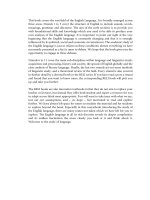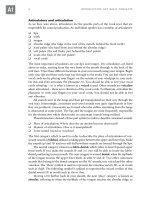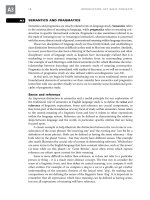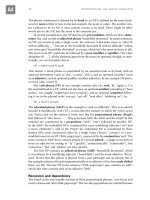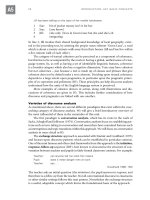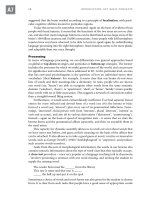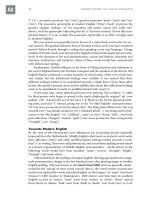Introdungcing English language part 13 pdf
Bạn đang xem bản rút gọn của tài liệu. Xem và tải ngay bản đầy đủ của tài liệu tại đây (374.44 KB, 6 trang )
58 DEVELOPMENT: ASPECTS OF ENGLISH
CONSONANTS AND VOWELS
In all of the B sections, we will offer further discussion and explanation of the areas
that we introduced in Section A. Rather than providing extra detail on everything that
was introduced, we focus in this section on some of the significant aspects of the English
language. In this unit, for example, we examine the nature of consonants and vowels
in more detail.
Consonants
In A1, we introduced the three-part categorisation system for characterising the articu-
lation of a consonant: place, manner and voice. To develop our knowledge of this
process further, it is helpful to view these three different categorical elements in a
systematic format, which is most commonly achieved by viewing consonants in a grid
formation. However, before we do this, it is useful first to present a detailed list of the
range of consonant symbols of the English language so that you are familiar with the
symbols that belong to the International Phonetic Alphabet for consonant production.
Many of these symbols will be very familiar as they are the same as traditional
English spelling, though there are also some that are quite different. Alongside each
symbol is an example of a specific word to illustrate the particular sound quality that
is being represented. The exact part of the word which is being represented by the
phonetic symbol is underlined.
p–p
at
b–b
ad
t–tin
d–d
og
k–c
an
g–got
m –bu’
er (glottal stop)
m–m
an
n–tan
f – sing
r–road
f–flash
v–van
θ –thigh
q –the
s–sit
z–z
inc
t –sh
eep
n – leisure
h–h
am
l–l
oft
j–yet
tt –ch
urch
dn –j
udge
w–w
ipe
B1
CONSONANTS AND VOWELS 59
While the location of particular sounds within individual words is represented here
by underlining, there is a more principled way to characterise this, by referring to word
initial, word medial and word final position. For example, with /θ/, the example given
above (thigh) is word initial. This sound occurs in word medial position in author and
word final position in path. With /t/ a word initial example is given above with sheep.
It occurs word medially with fishes and in word final position in dish. The example
of church above contains /tt/ in word initial and word final position within the
same word. Such distinctions are important because sounds often change depending
on where they occur in a word.
You may have noticed that some consonants that exist in English spelling are not
present in the phonetic consonant symbols: the following letters are not listed above:
c, q, x or y. They are not required for phonetic representations in the English lan-
guage. The letter c is most often represented phonetically by either /k/ or /s/. The
former is referred to as hard c in words such as cat whereas the latter is referred to as
soft c in words such as cider. Additionally, in words such as cello, c is represented by
/tt/. The letter q is not required as it is articulated as [kw].
The letter x is represented by a combination of consonant sounds, either /ks/ as
in ox or, on rarer occasions and in some accents as /gz/, as in exam. However, there
is one exception to this with the letter x. In one particular variety, Scottish English,
/x/ is used as a phonetic symbol to represent the consonant sound in words such as
loch. We will come back to this below. Finally, the letter y is represented by /j/ as in
yet, as we have seen in the above list.
All of the different consonant symbols listed above can be placed upon a consonant
grid, which can function as a really useful cross-referencing tool for defining the three-part
classification system. Table B1.1 presents an example of such a grid. The place of articula-
tion categories introduced in A1 run horizontally and the manner categories run verti-
cally. You will notice that there are two sounds in some of the squares. Where you have
such consonant pairings, the sound on the left is always voiceless, whereas the sound on
the right is always voiced. If there is only one consonant in the box, remember that you
can ascertain whether it is voiced or voiceless by performing the vibration test described
in A1 – place your fingers on your vocal cords and physically test for evidence of vibration.
Consonant classification tends to take the order of voice, place, and manner. Test
out the usefulness of the above grid by identifying the IPA symbol for the following
consonant descriptions:
voiced velar nasal
voiced velar stop
voiceless dental fricative
voiceless bilabial stop
voiced labio-dental fricative
voiced palatal fricative
voiced alveolar lateral approximant
voiceless labio-dental fricative
Most consonant tables which focus solely on the English language do not tend to include
regional variants, but if we were to add the loch sound from Scottish English to the
grid, the symbol /x/ would live in the velar fricative column.
60 DEVELOPMENT: ASPECTS OF ENGLISH
You should now test the usefulness of the consonant grid in reverse by coming
up with the three-part description for the following consonant symbols: /m/ /f/ /s/
/tt/ and /n/.
Any speech sound can be symbolised using the IPA and described accurately using
the classification system as above. Even some non-speech sounds can be accounted
for in this way: a voiceless bilabial released ingressive stop (ingressive refers to when
the air in the airstream is pulled into the vocal tract) is a kiss.
Vowels
Before undertaking any formal study of the sound system of the English language,
there is a common perception that English has five vowels: a e i o u. While this is
the case for the Roman alphabet and the traditional orthographic written system of
modern English which you are presently reading, there are many more vowel sounds
which we make when we engage in spoken communication with one another. These
are represented through various symbols within the IPA.
The vowels of the English language can be categorised as pure vowels (also
referred to as monophthongs), or as diphthongs. Pure vowels/monophthongs are defined
as such as they have one single sound quality. You may also find these sounds referred
to as steady-state vowels, reflecting how the tongue and the lips are held in a steady
position when the vowel sound is articulated. In contrast, diphthongs have two
sounds and the speaker will make a transition from one sound to another in the pro-
duction of the vowel.
It is important to note that pure vowels can be split into short or long vowels
depending upon their duration – how long a sound takes to produce compared
with another sound. A long vowel is represented by the diacritic symbol £
which appears directly after the short vowel symbol, to signify the vowel length.
For example, the short vowel /a/ as in cat has a corresponding long vowel /a£/ as
in car.
Below is a summary of English language monophthongs and diphthongs. As with
the consonant list, the IPA symbols appear directly alongside specifically selected words
to illustrate the particular sound quality which is symbolically represented:
Table B1.1
The consonant sounds of the English language
Bilabial Labio- Dental Alveolar Palatal Velar Glottal
dental
Stop
Fricative
Affricate
Nasal
Approximant
Lateral
approximant
pb
m
fvab
td
sz
tf dc
n
r
l
fc
j
kg
g
w
v
h
CONSONANTS AND VOWELS 61
Monophthongs
short vowels
x –pit
e–pet
a–pa
t
o–po
t
w –putt
k –put
e – batter
long vowels
i£ –mea
n
$£ –bu
rn
a£ –farm
c£ –morn
u£ –moon
Diphthongs
ax –bi
te
εx –bai
t
cx –toy
ek –roe
ak –house
ke – cruel
xe – ear
εe – air
In A1 we briefly mentioned vowel trapeziums, the diagrammatic way in which vowel
sounds can be graphically represented on the tongue, sometimes referred to as vowel
quadrilaterals. An example of a vowel trapezium is given below. The eight vowels that
appear at specific points on the trapezium in Figure B1.1 are known as cardinal vowels.
Front Central Back
i
e
h
a
Close
Close-mid
Open-mid
Open j
l
o
u
Figure B1.1
Vowel trapezium of cardinal vowels
62 DEVELOPMENT: ASPECTS OF ENGLISH
The cardinal vowel system was devised by phonetician Daniel Jones in the early
twentieth century. It has been a highly influential model in aiding the description of
vowel sounds and it is still the dominant model used today. The term cardinal was
adopted, as the model follows a similar idea to the principle of the cardinal points on
a compass (north, south, east and west). The cardinal vowels are fixed points and the
quality of the vowel sounds that are produced by speakers can be identified by refer-
ence to these fixed points.
The ‘front’, ‘central’ and ‘back’ categories that run along the top of the trapez-
ium diagram refer to the positioning of the body of the tongue – basically how far
forward or retracted it is when the vowel sound is being made. The ‘close’ through to
‘open’ categories that run down the left-hand side refer to the positioning of the tongue
in relation to the roof of the mouth. If the top surface of the tongue is close to the
roof of the mouth, then these sounds can be identified as close vowels. If the tongue
is far away from the roof of the mouth, then the vowel sounds are termed open. On
some other vowel trapezium diagrams these positions are alternatively characterised by
the terms ‘high’ ‘mid’ and ‘low’, or a combination of these, as illustrated in Figure B1.2.
Front Central Back
i
e
h
q
m
a
Close
Close-mid
Open-mid
Open j
l
o
u
ko
Figure B1.2
Cardinal and central vowels
As we have already seen above, the IPA for English includes a number of other
vowels. The trapezium in Figure B1.2 illustrates the positioning of these other import-
ant monophthongs.
The vowel sound represented by the symbol /e/ is known as schwa, named after
the Hebrew vowel. It is sometimes termed a neutral vowel and is the most frequent
vowel sound in the English language. The /x/, /k/ and /w/ vowels, together with schwa,
are known as centralised vowel sounds. They are articulated in a central position in
the mouth, as graphically illustrated. If you relax your tongue, open your lips slightly,
and make a vowel sound (usually spelled in writing as ‘uh’), that is a schwa.
The shape of the lips is another category which is taken into consideration when
characterising vowel sounds. In order to incorporate different lip shapes, phoneticians
have identified different shapes within which phonetic symbols can be displayed. A
square ñ is used to indicate that lips are unrounded, often termed spread, whereas
a circle ï is used to indicate that lips are rounded. Rounded lips tend to be used for
CONSONANTS AND VOWELS 63
back vowels, including /u/ /o/ and /c/ whereas other English language vowels tend to
use unrounded lips. These shapes can be used on vowel trapeziums to signal lip-shape
in addition to location on the tongue.
With diphthongs, some sounds start with rounded lips and end with spread lips,
others start with spread and end with rounded lips. For example, /ek/ as in roe starts
with spread lips and ends with rounded. The following symbol represents this diph-
thong lip shape: ó. Other diphthongs will start off with rounded lips and end up with
spread lips, as in /ke/ for cruel. This transition in lip shape is represented by the
following symbol: ò. Make these sounds out loud in front of a mirror so that you can
physically see the difference with the positioning of your lips.
Accent
Knowledge of phonetics and phonology is crucial for research into accent, the study
of pronunciation (see A9). Many phoneticians who work on the English language are
interested in describing and cataloguing variations that exist between the accents of
groups of English speakers from different regional and social backgrounds. In order
to undertake such investigations, a good foundational knowledge of vowel and con-
sonant sounds is essential. Researchers who conduct investigations of accent variations
are referred to as sociophoneticians or sociolinguists, examples of whose work can
be seen throughout strand 9.
In the list of consonants above, there are 24 sounds listed, plus the glottal stop.
Received Pronunciation, or RP, the social accent traditionally imbued with the most
prestige in England, has 24 consonant sounds, excluding the glottal stop, which is instead
traditionally associated with regional accents. Historically, RP has been used as the
benchmark reference point for phonetics sounds in many textbooks. However, as we
will see in B9, language loyalty to RP is dying out. Indeed, some authors have started
instead to take what they term Non-Regional Pronunciation as their starting point
for consideration of phonetics and phonology (for example, Collins and Mees 2009).
Non-regional pronunciation can involve the use of glottal stops on occasions for the
articulation of certain words (see D1, B9 and C9 for further discussion of language
loyalty and particular phonetic speech features).
Furthermore, as we have seen already above, if we want to be inclusive of other
varieties then there is a need to include other symbols, such as /x/ to denote the loch
consonant sound in Scottish English. In C1, we will look in more depth at accent
variation by focusing on different examples and texts to enable you to explore this
important application of phonetics and phonology further.
Consonant classification answers
voiced velar nasal: /f/
voiced velar stop: /g/
voiceless dental fricative /0/
voiceless bilabial stop: /p/
voiced labio-dental fricative: /v/
voiced palatal fricative: /n/
voiced alveolar lateral approximant: /l/
voiceless labio-dental fricative: /f/
SWIN|KCrEIB1Qqc8svpQueSEh0w==|1282035836

